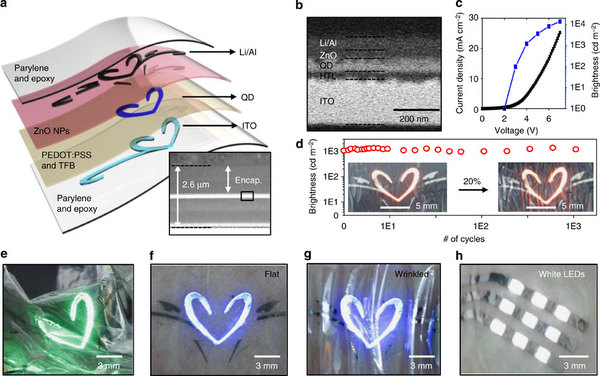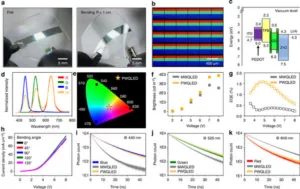Kim Dae-hyeong, a researcher at the Institute for Basic Science (IBS) has developed a flexible LED cell called QLED that refers to a “quantum dot light emitting diode”, as reported by The Korea Times. The article does not describe the specific technology other than that the cell is very thin (2.6 micrometer) and can be produced in a pixel density of up to 2,460 ppi. It continues that this kind of display can be used as an electronic tattoo.
However, at the same time, a paper published in Nature, called “Wearable red–green–blue quantum dot light-emitting diode array using high-resolution intaglio transfer printing”, by Kim Dae-hyeong et al seems to describe the same technology in a technical paper.
There have been many attempts to produce QDLEDs and according to this paper Kim Dae-hyeong et al have succeeded in producing such a cell based on electroluminescent quantum dots. This means that they combined the functionality of an organic LED and a quantum dot in one device. This means that at the heart of the device is large molecule OLED material that can also be tuned to any desired wavelength by controlling its size. The paper states that they are using CdSe/ZnS alloyed QDs that have the same type of ligand, oleic acid. They call these particles colloidal nanocrystals or NCs. The paper describes the materials and how they synthesized the particles.
The following image shows the make up of the cell as well as some results from actual device prototypes.
Source: “Wearable red–green–blue quantum dot light-emitting diode array using high-resolution intaglio transfer printing”, Nature
They also state that they achieved a peak brightness of 14,000 cd/m² at a driving voltage of 7V.
In addition, the cells were produced by an intaglio printing process that creates a very thin cell structure with very high resolution capabilities. The following image shows how a flexible tattoo cell is designed and the achieved cell capabilities, as well as functionality versus bending cycles.

The interesting part is the ability to create a very thin cell. At this thickness the cell cannot only be bent in one direction, but in several directions at once. When you think of a flexible OLED display of today it is slightly bent around one edge, as in the Samsung smartphone, but never in two directions at once, as would be necessary in a corner. This technology would help to achieve a true flexible display.
The following video shows a prototype achieving just this. (We found some problems with browser plug ins on this movie, but you can download from this link
As can be seen in the video, the display works while being stretched or crumbled, which is very impressive indeed. However, we have to remember that a brand new display technology like this has to overcome many hurdles before it can become a consumer viable product. Nevertheless, this technology promises truly flexible displays of the type we carry in our pocket and which stretch when needed. – NH

